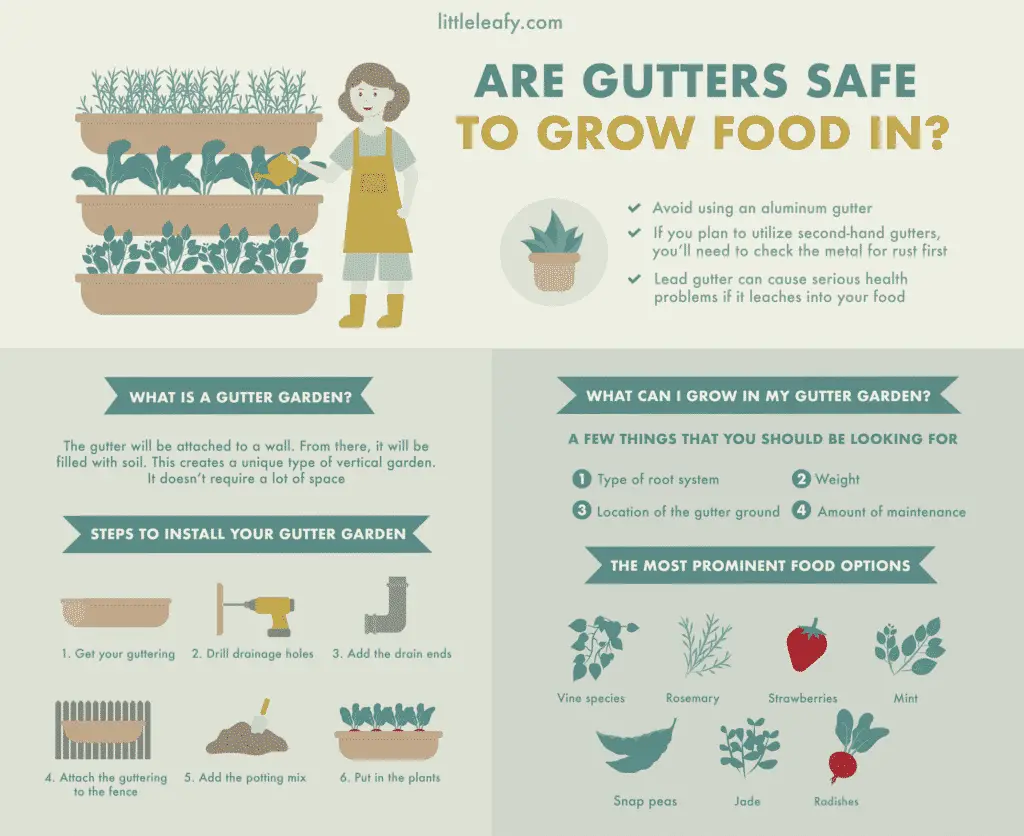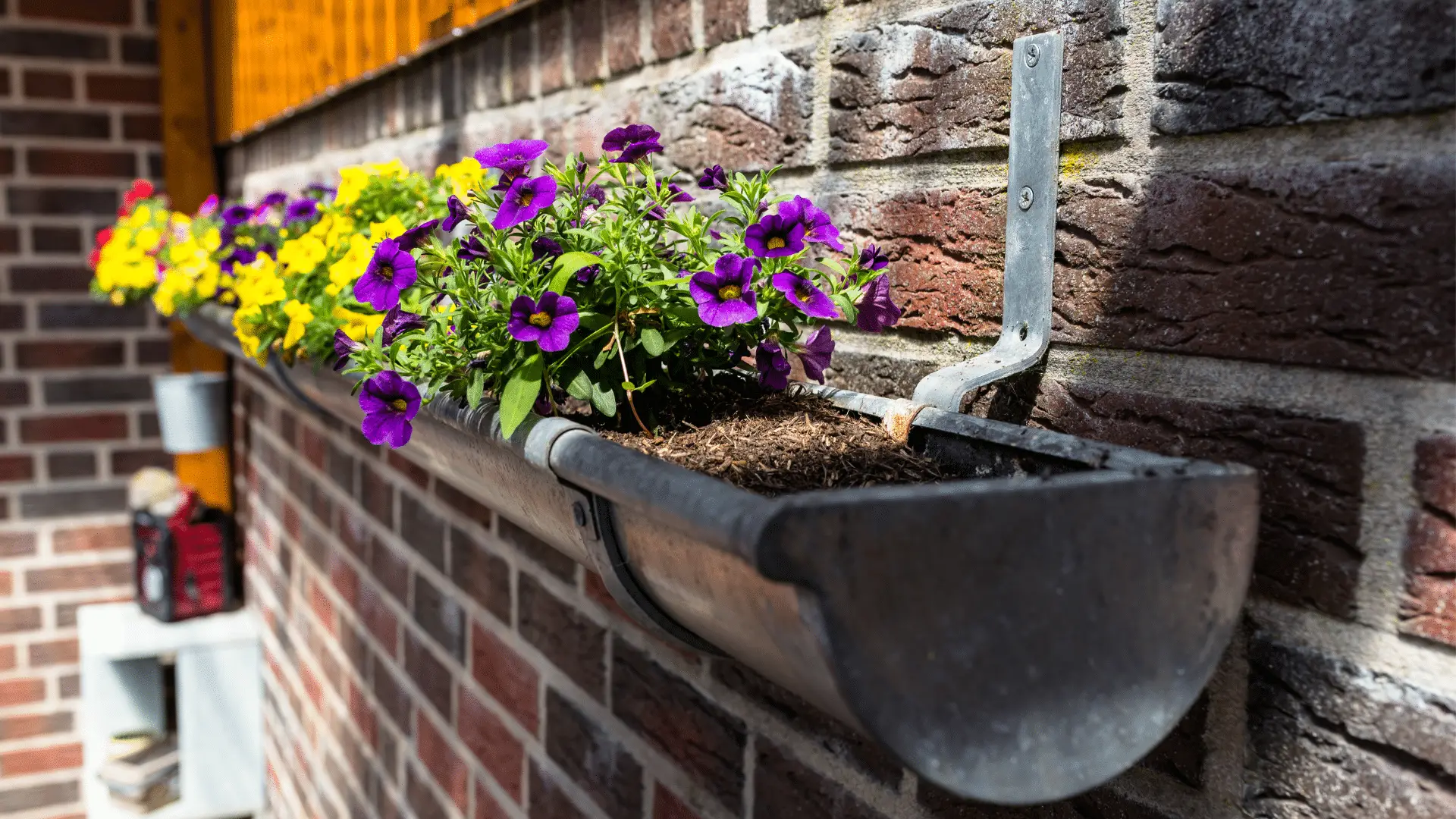Reading Time: 5 minutes 🍃
If you are struggling to find space for your garden, you might want to consider getting a gutter garden. These are easy to install and fill with soil. But this raises a bigger question, is using guttering as part of your garden safe?
You should be able to grow food in a gutter garden safely. You need to make sure that the guttering is free from lead. Furthermore, you won’t be able to use the gutters on your roof. Too much weight and they can fall off, leaving a hefty repair bill.
If you are planning on growing a gutter garden, there are a few things that you need to know. One of the most important is to decide what plants you will be able to use. Keep reading to learn more about the best way to set up a gutter garden.
What is a Gutter Garden?
Growing a gutter garden has started to become more popular around the world. The gutter will be attached to a wall. From there, it will be filled with soil. This creates a unique type of vertical garden. It doesn’t require a lot of space. Plus, it will be the cheapest type of garden you can make. All you need to do is take a trip into the local hardware store to buy some basic supplies.
What Can I Grow in my Gutter Garden?
Let’s start by looking at one of the essential elements, what types of plants you will grow. There are lots of options for you to choose from, but there are a few things that you should be looking for. These considerations include:
- Type of root system. It’s important to choose something that has shallow roots. A gutter won’t be big enough to support a deeper system. Instead, it will work best for plants that have roots that spread sideways.
- Weight. Often, your guttering won’t be able to support a lot of weight. Because of this, it will be best suited for smaller plants.
- Location of the gutter ground. It’s also important to consider where you will be putting the gutter garden. This will affect a range of elements. For example, it’s important to consider the amount of sunlight that your garden will be getting and whether it will be getting any rain.
- Amount of maintenance. It’s important to consider your needs when you are choosing a garden. Do you want to get something that will require you to do a lot of work, making sure that everything is kept in good condition? Or you are looking for some low-maintenance plants?
The good news is that there are plenty of plants that will thrive in a gutter. This includes plants that are mainly grown for food. It can also be a good choice for using a gutter garden to show off flowering plants. Some of the species that you can use include :
:
- Snap peas
- Mint
- Strawberries
- Radishes
- Rosemary
- Jade
- Vine species
Though these are some of the most prominent options, there are plenty of other options that you will be able to grow in a gutter.
Is Growing Food in a Gutter Garden Safe?
Just because you will grow food in a gutter doesn’t mean that it’s a good idea. Often, this will depend on the type of guttering that you are using. There are a few things that you will need to be wary of.
First, you should avoid using an aluminum gutter. There is a risk that this will leach into the soil. This can lower the pH level . This will start to impact your plants, mainly if they are sensitive to these changes. The good news is that aluminum is unlikely to have a significant impact on your health.
. This will start to impact your plants, mainly if they are sensitive to these changes. The good news is that aluminum is unlikely to have a significant impact on your health.
If you plan to utilize second-hand gutters, you’ll need to check the metal for rust first. Generally, rust won’t cause any problems for plants, as they can’t absorb the metal. Interestingly, there won’t be any health issues that stem from accidentally ingesting rust for most people. But widespread rusting can mean that the gutter will be unable to cope with the weight of the soil and plants.
The most significant risks, though, come from using a lead gutter. This was a fairly common building material, particularly in older gutters. It was most common before 1970. If you have gutters from this era, it’s a good idea to get them tested before you start planning in them. If the lead finds a way of leaching into your food, it can cause serious health problems . This can sometimes lead to high blood pressure and might damage your liver.
. This can sometimes lead to high blood pressure and might damage your liver.
Finally, you don’t want to use the gutters that are attached to your house. Get guttering from the store and attach it to a fence or wall. If you try to use your roof guttering, you run the risk of ruining your house. As the dirt accumulates and the plants grow, it will get heavier. In some cases, the weight will cause the gutters to fall off your roof. At other times, it will disrupt water flow, causing damage.
Tips for Growing in a Gutter
Growing plants in a gutter can be a great way of creating a green space in your home. It will only take a few minutes to set up and should be pretty easy for you to take care of. To make sure that everything goes smoothly, there are a few tips that you will need to use. These are:
- Choose the right type of guttering. There are a few types of guttering that you will be able to use. You might want to use metal. Stainless steel will last for a long time. On the other hand, plastic will be lighter and easier to cut.
- Put the garden on the western fence. You’ll need to think about where the sun will hit the gutter. Because of this, it’s best to put it on the western fence. This is where you will be able to get the heat from the afternoon sun, which is best to help plants thrive.
- Pick a strong fence or wall. Remember, these gardens can get very heavy. You’ll need to choose something that will be able to cope with this weight.
Steps to Install Your Gutter Garden
If you like the idea of using a gutter garden, it’s time to think about how you are going to install it. The good news is that it’s relatively easy. You need to follow these simple steps :
:
- Get your guttering.
- Drill drainage holes. You’ll need to put two to five holes in the bottom of your gutter for the water to drain out. You don’t need anything too big, or you risk the soil falling out.
- Add the drain ends. Often, you’ll just need to glue these into place. Leave a few hours for it to set.
- Attach the guttering to the fence. It’s often best to screw it in. Remember to put it at a slight angle, so the water drains properly.
- Add the potting mix.
- Put in the plants. Sometimes, you will need to add a little mulch or compost to your garden, so the plants have the nutrients they need to thrive.
Final Thoughts

There are plenty of innovative ways to grow your garden in a limited space. One of the most popular new trends is to use a gutter garden. As long as you are selective about the type of guttering you are using, it should be perfectly safe for you to set up this type of garden. This will allow you to grow various plants, everything from strawberries and flowers to kitchen herbs.

